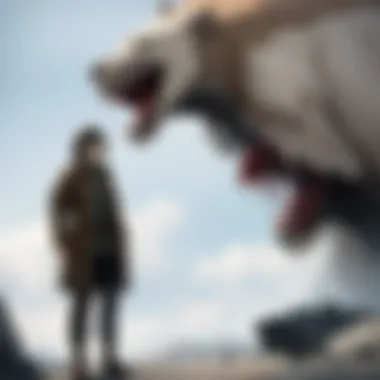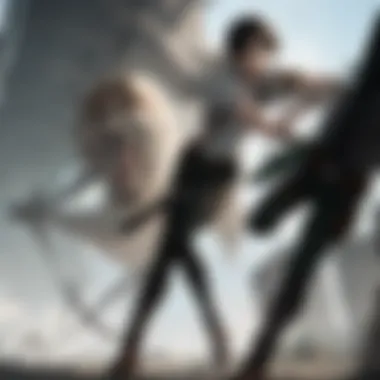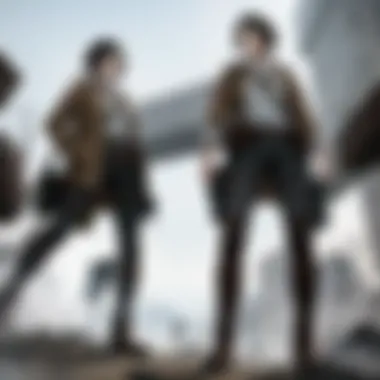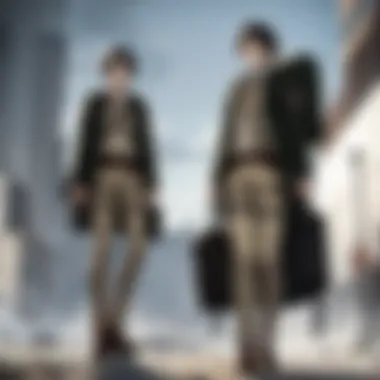A Critical Examination of Attack on Titan


Intro
"Attack on Titan," a work crafted by Hajime Isayama, is a phenomenon that has captivated audiences around the world. This series set in a dystopian reality where humanity fights for survival against giant humanoid creatures known as Titans challenges our perceptions of freedom, morality, and governance.
The series blends action-packed sequences with profound philosophical questions, making it not only entertaining but also thought-provoking. The complexities of individual character arcs, the exploration of socio-political themes, and the distinctive animation work all contribute to its recognition as a landmark in the anime and manga community.
As we undertake this examination, we aim to illuminate the key aspects that define the series and establish its relevance in contemporary culture.
Prelims to Attack on Titan
The significance of Attack on Titan cannot be overstated. As a pivotal work in both anime and manga landscapes, it invites countless interpretations and discussions. This series transcends mere entertainment, extending into realms of cultural commentary and philosophical exploration. This article seeks to dissect the various elements of Attack on Titan, unpacking its complex narrative and its rich character development.
In the context of this article, we will examine the origins and publication history of the series, along with its cultural significance both in Japan and globally. Understanding these aspects provides a foundation that informs the broader themes and impacts of the narrative.
The Attack on Titan phenomenon prompts critical questions about humanity and society. This contrasts the enthralling story with the intricate questions it raises about identity and freedom. As we delve deeper, it becomes evident that the series accomplishes more than securing a place in hearts of fans; it invites serious consideration of the human condition itself.
Origins and Publication History
Attack on Titan firstly appeared in the pages of Bessatsu Shounen Magazine in September 2009. Written and illustrated by Hajime Isayama, this work burst onto the scene with its unique blend of horror and fantasy. The initial chapters received lukewarm reception but gradually gained traction due to their gripping storytelling and distinct art style. By the series’ end in April 2021, it had amassed over 100 million copies in circulation, showcasing its astounding popularity.
The serialization process faced numerous challenges. Isayama navigated issues such as balancing character development with plot progression. As the story evolved, he frequently adjusted the narrative's direction based on reader feedback and his artistic vision. This adaptability played a critical role in maintaining engagement throughout the series.
The anime adaptation first aired in April 2013, further expanding its reach. With each season, the animated series attracted both domestic and international audiences, elevating the manga’s status to a global phenomenon.
Cultural Significance in Japan and Abroad
Attack on Titan has woven itself into the fabric of contemporary culture, both in Japan and abroad. It sparked discussions about freedom, oppression, and the nature of humanity. The gripping tale resonated with many, striking chords in societies facing their struggles. In Japan, it reflects post-Fukushima sentiments of anxiety and vulnerability. Many viewers draw parallels between the series' conflicts and their own lives, making it a resonant commentary on modern issues.
Outside Japan, the series has been embraced by diverse audiences. The themes of conflict and survival attract a wide range of viewers who might not typically engage with anime or manga. Online communities, particularly on platforms like Reddit, have fostered discussions that dissect the narrative and characters, reflecting the work’s universal relevance.
In essence, Attack on Titan has become more than a story—it’s a cultural touchstone that invites ongoing dialogues. Its impact is clear, influencing not just entertainment but also academic analysis, fan contributions, and artistic expressions worldwide.
Plot Overview
The plot overview is a critical aspect of understanding Attack on Titan, as it encapsulates the fundamental narrative and thematic patterns that unfold throughout the series. The narration guides viewers and readers into a world where humanity struggles for survival against gargantuan humanoid creatures known as Titans. This foundation not only serves as the backdrop for character development but also establishes the thematic focal points that resonate deeply within the narrative. Analyzing the plot allows for a better appreciation of character motivations, conflicts, and the ultimate resolutions presented in the series.
The Setting and Its Implications
Attack on Titan is set in a dystopian world characterized by towering walls that protect the remnants of humanity from the Titans. This unique setting has implications that extend beyond mere geography. The walls symbolize safety but also restriction, representing the duality of freedom and confinement central to the story's themes. Within these confines, characters grapple with their confined existence while questioning the truths they have been taught.
The world is further divided into various districts and social structures which highlight disparities in power, class, and privilege. The sense of isolation experienced by characters is compounded by the fear of the Titans, which can be interpreted as both a literal and metaphorical representation of the unknown. As the plot progresses, the true nature of the world outside the walls is revealed, raising crucial questions about identity, purpose, and the fate of humanity. This setting allows for a nuanced exploration of oppression and freedom, setting the stage for deeper philosophical inquiry.
Main Story Arcs and Progression
The main story arcs of Attack on Titan drive the narrative forward while interweaving complex character trajectories. The progression begins with the inciting attack of the Titans, leading to the loss of Eren Yeager’s mother, which propels him into a relentless pursuit of revenge and truth. This serves as a catalyst for his transformation from an ordinary citizen to a key figure in humanity's defense.


Key arcs include:
- The Battle of Trost District - This arc emphasizes teamwork as characters unite against a common enemy for the first time.
- The Female Titan Arc - This installment reveals not only the existence of intelligent Titans but also deepens the plot with themes of betrayal and identity.
- The Shinganshina Arc - Central to the overall narrative, it explores the origins of the Titans and the history of the human race, culminating in significant revelations and shifts in character loyalties.
Each arc integrates character development, social dynamics, and moral dilemmas, pushing the audience to engage with questions surrounding leadership and ethics in the face of adversity. Character arcs often mirror the overarching narrative, making the story's progression not just chronological but also a means of exploring complex human emotions and societal issues.
As the plot unfolds, themes of sacrifice, choice, and the moral ambiguity of survival are laid bare, encouraging viewers to reflect on their understanding of humanity itself.
Character Analysis
In any narrative, characters serve as the backbone, providing depth to the storyline. In Attack on Titan, characters are complex and multidimensional. Analyzing characters like Eren Yeager, Mikasa Ackerman, and Armin Arlert reveals key themes and motives hidden within the plot. Each character's journey reflects broader philosophical questions, showcasing how individual beliefs shape actions under extraordinary circumstances. Understanding character motivations enhances the reader's connection to the narrative, allowing for a more profound encounter with Attack on Titan's rich world.
Eren Yeager: Transformation and Ideology
Eren Yeager is ostensibly the heart of Attack on Titan. His evolution from a naive child into a formidable force embodies the series' exploration of freedom and sacrifice. Initially, Eren seeks to eradicate the Titans for personal vengeance. However, as the story progresses, his ideology shifts. Eren’s transformation raises crucial questions about morality, choice, and the cost of achieving one's goals.
Eren's character challenges viewers to consider the fine line between heroism and villainy. At one point, he is simply a protector of humanity; at another, he embraces a destructive path. This duality invites discussions about the nature of power and its implications, making Eren a vital component in exploring deeper philosophical themes within the series.
Mikasa Ackerman: Agency and Loyalty
Mikasa Ackerman stands as a beacon of strength and support for Eren. Her unwavering loyalty illustrates the complexity of personal agency in dire situations. While she is often depicted as the ultimate protector, her character grapples with her own desires and fears. Mikasa's pursuit of identity beyond her attachment to Eren is significant.
Her journey reflects the struggles many face: the tension between following one's heart and establishing individual identity. Mikasa is not just a fighter; she is a compass guiding Eren in times of turmoil. This highlights the theme of loyalty versus self-determination, compelling viewers to reflect on their values and priorities amidst chaos.
Armin Arlert: Intelligence vs. Strength
Armin Arlert serves as a contrast to both Eren and Mikasa, representing the power of intellect over brute force. Early in the series, Armin is portrayed as timid and uncertain. Yet, as events unfold, he often emerges as the strategic mind behind pivotal moments. His character speaks to the importance of intelligence and strategy in survival.
Armin's development from insecurity to self-assuredness demonstrates that strength is not only physical but also mental. He consistently advocates for peace, a perspective that diverges sharply from Eren's increasingly drastic measures. This divergence encapsulates the critical dialogue regarding how strength is defined. In a world filled with giants, it becomes clear that Attack on Titan values intellect just as much as it does physical prowess, reflecting differing pathways to agency and impact within narrative structures.
Themes Explored in Attack on Titan
In examining Attack on Titan, one cannot overlook the rich tapestry of themes interwoven throughout the narrative. The significance of these themes not only drives the plot but also elevates the work beyond mere entertainment. This section delves into three core themes: freedom and confinement, the nature of humanity, and the consequences of war. Each theme prompts reflection and discussion among viewers, inviting them to consider their implications both within the world of the series and in real life.
Freedom and Confinement
The theme of freedom and confinement permeates Attack on Titan, manifesting in various aspects of the storyline and character experiences. The walls that surround the remnants of humanity symbolize both physical and psychological barriers. Characters grapple with the desire for liberation from titan oppression, mirroring real-world struggles against societal limitations.
Eren Yeager's relentless pursuit of freedom prompts a complex discussion about what it means to be truly free. Is physical liberation sufficient, or does freedom also require a conscious and ethical framework? Through his journey, the narrative raises questions about the costs associated with seeking freedom and the implications of actions taken in its pursuit.
"Freedom is not worth having if it does not include the freedom to make mistakes."
This quote encapsulates a core dilemma within the series. As Eren's ideologies evolve, viewers are challenged to consider how much control one has over their fate and the ethical dimensions of that control.
The Nature of Humanity


Attack on Titan also embarks on an exploration of what it means to be human. The frequent confrontation with titans blurs the lines between monster and humanity, prompting reflective thought on moral dualities. The titans, often depicted as fearsome beasts, inhabit a narrative space that invites viewers to ponder their origin and motivations. Are they inherently evil, or are they victims of circumstance?
This theme forces characters like Armin and Mikasa to confront their fundamentally human attributes: compassion, fear, and the will to survive. Armin's strategic brilliance often contrasts with the raw brutality shown by others, highlighting the complexity of human nature. The narrative invites the audience to question whether humanity is defined by noble intentions or brutal survival instincts.
War and Its Consequences
Finally, Attack on Titan provides a poignant commentary on war and its ramifications. The continuous cycle of violence throughout the series echoes historical conflicts in our world, where the consequences extend far beyond the battlefield. Characters experience loss, trauma, and moral dilemmas, challenging the glorification of combat and heroism.
The emotional fallout of war is explicitly illustrated through the experiences of main characters. The decisions made in the heat of battle resonate long after the conflict ends, affecting relationships and personal identities. This theme accentuates the reality that every action has a consequence, making viewers contemplate the long-term effects of war.
In summary, the themes explored in Attack on Titan serve as a conduit for deeper understanding. Through the lenses of freedom and confinement, the nature of humanity, and the impact of war, the series compels its audience to engage with significant philosophical and ethical questions, thus affirming its relevance in both anime and broader cultural discussions.
Artistic Style and Animation
Artistic style and animation serve as the backbone of any anime, and Attack on Titan exemplifies this with its unique visual language. The series not only captivates the viewer's eye but also reinforces its themes and character narratives. Through careful artistic choices, Attack on Titan articulates deeper emotional contexts and societal reflections. Each frame contributes to a storytelling experience that is as crucial as the plot itself.
Character Design and Evolution
The character design in Attack on Titan is marked by distinctiveness and evolution. Each character's appearance reflects their personality and the arcs they undergo. For instance, Eren Yeager's transformation from a determined youth to a complex figure is mirrored in his design. Initially, he presents as an innocent, spirited boy, which contrasts starkly with his later darker, more brooding appearance. This evolution in design underscores thematic undercurrents such as loss and moral ambiguity.
In addition, Mikasa Ackerman’s design emphasizes strength and resilience through her athletic build and practical clothing, a stark deviation from typical portrayals of female characters in anime. The designs are not merely aesthetic; they serve as verbal cues that guide viewer perception of character development throughout the series.
Visual Symbolism in Scenery
Scenery plays a fundamental role in Attack on Titan, often laden with visual symbolism. The walled cities, stark landscapes, and the ever-present titans embody the themes of confinement and fear. For example, the towering walls represent both physical and psychological barriers the characters face. As characters navigate through these landscapes, the settings reflect their internal struggles, advancing the narrative visually.
The strategic use of colors further amplifies emotional responses. Dark, muted tones often accompany moments of tension, while brighter hues emerge during scenes of hope or revelation, subtly guiding audience emotions. This intricate interplay between visuals and narrative elevates the series beyond a mere action-oriented plot.
Animation Techniques and Their Impact
The animation techniques employed in Attack on Titan cultivate a visceral viewing experience. One notable aspect is the fluidity of motion during action sequences, which heightens tension and excitement. The use of three-dimensional maneuver gear, a signature element of the show, is animated with precision. This not only makes the fight scenes exhilarating but also conveys the characters' agility and desperation.
Moreover, the integration of CGI with traditional animation further enhances visual storytelling. It allows for dynamic camera angles and expansive scenes that would be difficult to achieve with 2D animation alone. The result is an immersive experience that captivates viewers and keeps them engaged in the unfolding drama.
"Animation is not just about creating movement, but about expressing ideas and feelings that resonate with the viewer."
In summary, the artistic style and animation of Attack on Titan are not mere embellishments; they are pivotal to the storytelling process. The character designs adapt to reflect their evolving arcs, scenery becomes a narrative tool laden with symbolism, and innovative animation techniques create an engaging environment. Together, these elements ensure that the series leaves a lasting impact on its audience.
Socio-Political Commentary
The socio-political commentary inherent in Attack on Titan serves as a crucial framework for understanding the series. It goes beyond mere entertainment; it engages viewers and readers in thoughtful dialogue about societal structures, human behavior, and moral dilemmas. These themes resonate deeply within the context of contemporary social issues, making the narrative not just relevant but necessary for discourse surrounding power dynamics and the consequences of conflict.
The Reflection of Real-World Issues
Attack on Titan intricately mirrors various real-world issues, from authoritarianism to the struggle for freedom. The series portrays a society confined by walls, echoing themes of oppression present in many countries. The Titans symbolize various forms of existential threats that humanity faces, reflecting fears rooted in political and social unrest. The portrayal of fear, isolation, and the fight for survival resonates on multiple levels, making it a rich subject for analysis.


The depiction of Marley's oppressive regime and Eren's eventual transformation into a controversial figure embodies the duality of power. It is essential to recognize that this complexity is not merely a plot device but a commentary on the cycles of violence that nations often perpetuate. Bold ideas about vengeance and retribution are presented with moral ambiguity, prompting introspection about how societies grapple with past traumas and the consequences of conflict. This portrayal encourages viewers to critically consider how these themes manifest in their own reality.
Narrative as a Cultural Commentary
Beyond reflecting real issues, Attack on Titan serves as a cultural commentary that challenges viewers to confront uncomfortable truths. The series delves into the nature of propaganda, scapegoating, and the loss of individuality in the face of societal pressures. Each character's evolution mirrors larger societal conflicts, emphasizing that personal identities can become lost amid overarching narratives imposed by the state or society at large.
This narrative structure allows Attack on Titan to critique the blind nationalism and xenophobia that often shroud discussions around identity and belonging. Characters such as Eren, Mikasa, and Armin showcase how personal convictions can clash with larger political narratives, making their journeys as much about self-discovery as they are about survival.
For fans and critics alike, the importance of understanding this socio-political commentary cannot be overstated. It pushes audiences to reassess their perceptions of morality, loyalty, and resilience in turbulent times. The series serves as a reminder that historical patterns often repeat themselves, and it is through understanding these patterns that societies can hope to break free from cycles of oppression.
Reception and Impact
The reception and impact of Attack on Titan are vital to understanding its place in modern anime and culture. The series not only garnered critical acclaim but also became a cultural phenomenon that resonated with audiences worldwide. This section will analyze the constructive critique it received as well as its broader significance in terms of fandom and social engagement.
Critical Acclaim and Awards
Attack on Titan was met with positive reviews since its debut. Critics often praised its engaging storytelling, deep character development, and stunning animation. The series has won numerous awards, affirming its place in anime history. A few notable accolades include:
- Tokyo Anime Award for Animation of the Year
- Harvey Awards recognizing excellence in manga
- Crunchyroll Anime Awards, multiple nominations and wins
These accolades showcase not just the series' popularity but its quality. Reviewers commonly refer to its ability to tackle complex themes while entertaining its audience. The blend of intricate plotlines with intense emotional stakes captivates viewers in a way few other series accomplish.
The significant praise from critics and awards received reflect the series' success. However, one cannot overlook the importance of audience reception. Fans actively engage with Attack on Titan through various platforms, discussing episodes and expressing their thoughts on social media. This engagement can shape the narrative's trajectory, influencing future portrayals and developments.
Cultural Phenomenon and Fandom
Beyond awards, Attack on Titan has transformed into a cultural phenomenon. Its narrative addresses pressing issues like freedom, oppression, and the consequences of war. This resonance has inspired widespread discussions that extend beyond the screen to real-world implications.
The fandom surrounding Attack on Titan is extensive. Fans engage in a multitude of activities that bolster the series' popularity:
- Fan Art: Creating art that celebrates their favorite characters or moment.
- Fan Theories: Speculating about plot twists and character developments, sharing their interpretations in forums like Reddit.
- Merchandise: Purchasing various merchandise, from figurines to apparel, displaying their support for the series.
This culture of deep involvement contributes to the series' longevity. The active online communities cultivate a shared experience among viewers, fortifying the emotional connections to the show.
In summary, the impact of Attack on Titan extends far beyond entertainment. The critical acclaim it has received is a testament to its artistry, while its cultural resonance highlights how deeply it connects with societal issues. The series continues to engage fans in ways that few other franchises can match.
Culmination
The conclusion serves as a critical juncture within this article, emphasizing the overall significance and lasting impact of 'Attack on Titan' in various dimensions of contemporary culture. As we have explored through its narrative structure, character dynamics, and thematic examinations, it becomes apparent that this work is more than just entertainment.
Legacy of Attack on Titan
The legacy of 'Attack on Titan' is multifaceted. It has reshaped the landscape of anime and manga, fostering a new wave of storytelling that balances complex themes with engaging action. Notably, the series has contributed to broader discussions on freedom, morality, and the human condition. Fans and critiques alike note that its influence can be seen in subsequent works, pushing creators to consider deeper narratives and character development.
Some key points of its legacy include:
- Influence on Genre: Its unique blend of horror and political themes has set a precedent for others.
- Cultural Discussions: The series has instigated conversations regarding nationalism and identity among audiences.
- Media Expansion: From an anime adaptation to video games and spin-off manga, its reach continues to grow.
Future Directions in Storytelling
Looking ahead, the future of storytelling in similar media may draw inspiration from the techniques laid out by 'Attack on Titan'. As creators grapple with increasingly complex societal issues through narrative, the potential for rich, thought-provoking content is vast. Challenges remain, such as ensuring accessibility for a global audience while maintaining artistic integrity. However, with the insights gained from 'Attack on Titan', creators might explore new narratives that mirror current events, much like its predecessor.
In summary, the conclusions drawn here reflect a profound recognition of 'Attack on Titan' as a pivotal work that unlocked new dimensions in anime and storytelling. Its legacy informs future directions in the discipline, promising a rich landscape of content that remains both culturally relevant and artistically innovative.



